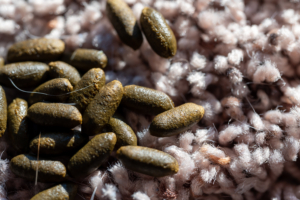
When it comes to pest control, one of the most common and concerning issues homeowners face is a mouse infestation. Mice are not only a nuisance but also a health hazard, as they can carry diseases and contaminate food sources. One of the key indicators of a mouse problem is the presence of mouse droppings. Identifying mouse droppings early can help you take swift action to address the infestation before it becomes a larger issue. In this blog post, we’ll dive into everything you need to know about mouse droppings, including how to identify them, why they’re a problem, and how Solutions Pest Control can help you tackle the issue effectively.
What Are Mouse Droppings?
Mouse droppings are the fecal matter left behind by mice as they move through your home. These droppings are small, dark, and pellet-shaped, often resembling grains of rice or small seeds. While they may seem insignificant at first glance, mouse droppings are a clear sign that mice have made themselves at home in your living space.
Mice are prolific breeders, and a single pair can produce dozens of offspring in a short period. This means that even a small number of droppings can indicate a larger infestation. Identifying mouse droppings early is crucial to preventing the problem from escalating.
How To Identify Mouse Droppings
Identifying mouse droppings is the first step in addressing a potential infestation. Here’s a detailed guide to help you recognize them:
1. Size And Shape
Mouse droppings are typically 3-6 mm in length and about 1-2 mm in width. They are small and cylindrical, with pointed ends. Fresh droppings are soft and moist, while older droppings become hard and crumbly over time.
2. Color
Fresh mouse droppings are dark brown or black. As they age, they may fade to a lighter brown or gray color. The color can help you determine how recent the droppings are, which is useful for assessing the severity of the infestation.
3. Location
Mice tend to leave droppings in areas where they travel or nest. Common locations include:
- Kitchens: Near food sources, under sinks, or inside cabinets.
- Basements and Attics: These areas provide shelter and are often undisturbed.
- Along Walls: Mice prefer to travel along edges and walls, so droppings are often found in these areas.
- Near Entry Points: Check around doors, windows, and cracks in the foundation.
4. Quantity
A few droppings may indicate a single mouse, while a large number of droppings suggests a more significant infestation. Mice can produce 40-100 droppings per day, so the quantity can quickly add up.
5. Other Signs
In addition to droppings, look for other signs of mice, such as:
- Gnaw Marks: Mice chew on wood, plastic, and wires to keep their teeth sharp.
- Nests: Mice build nests from shredded paper, fabric, or insulation.
- Urine Stains: Mouse urine can leave behind a strong, musky odor and visible stains under UV light.
Why Mouse Droppings Are A Problem
Mouse droppings are more than just an unsightly mess—they pose serious risks to your health and home. Here’s why you should take them seriously:
1. Health Risks
Mouse droppings can carry harmful bacteria and viruses, including:
- Hantavirus: A potentially life-threatening disease transmitted through contact with droppings, urine, or saliva.
- Salmonella: A bacterial infection that can cause food poisoning.
- Leptospirosis: A bacterial disease that can affect both humans and pets.
Inhaling dust contaminated with mouse droppings can also lead to respiratory issues, especially for individuals with allergies or asthma.
2. Contamination
Mice often forage for food in kitchens and pantries, contaminating food sources with their droppings and urine. This can lead to foodborne illnesses and costly food waste.
3. Property Damage
Mice are notorious for chewing through wires, insulation, and structural materials. This can lead to electrical fires, water leaks, and costly repairs.
4. Rapid Infestation
Mice reproduce quickly, and a small problem can escalate into a full-blown infestation in a matter of weeks. Ignoring mouse droppings can result in a larger, more difficult-to-control population.
What To Do If You Find Mouse Droppings
If you’ve identified mouse droppings in your home, it’s important to take immediate action. Here’s a step-by-step guide:
1. Clean Up Safely
Before cleaning, take precautions to protect yourself from exposure to harmful pathogens:
- Wear gloves and a mask.
- Avoid sweeping or vacuuming droppings, as this can release harmful particles into the air.
- Use a disinfectant or a mixture of bleach and water to clean the area.
- Dispose of droppings in a sealed plastic bag.
2. Inspect Your Home
Look for entry points, nesting areas, and other signs of mice. Common entry points include gaps around doors, windows, and utility lines.
3. Seal Entry Points
Use caulk, steel wool, or other materials to seal cracks and holes that mice could use to enter your home.
4. Set Traps
Traps can help reduce the mouse population. Place them in areas where droppings are found, such as along walls or near food sources.
5. Call A Professional
While DIY methods can be effective, a professional pest control service like Solutions Pest Control can provide a comprehensive solution to eliminate mice and prevent future infestations.
How Solutions Pest Control Can Help
At Solutions Pest Control, we specialize in identifying and addressing mouse infestations quickly and effectively. Here’s how we can help:
1. Thorough Inspection
Our trained technicians will conduct a detailed inspection of your home to identify the extent of the infestation, entry points, and nesting areas.
2. Customized Treatment Plan
We tailor our approach to your specific situation, using a combination of traps, baits, and exclusion techniques to eliminate mice and prevent their return.
3. Safe And Effective Methods
We prioritize the safety of your family and pets, using environmentally friendly products and methods to address the infestation.
4. Prevention Strategies
In addition to eliminating mice, we’ll help you implement preventive measures, such as sealing entry points and removing attractants, to keep your home mouse-free in the future.
5. Ongoing Support
We offer follow-up services to ensure the problem is fully resolved and provide tips for maintaining a pest-free home.
Preventing Mouse Infestations
Prevention is key to avoiding the hassle and health risks associated with mouse infestations. Here are some tips to keep mice at bay:
- Store Food Properly: Keep food in sealed containers and clean up spills promptly.
- Declutter: Remove clutter that can provide hiding spots for mice.
- Seal Entry Points: Regularly inspect your home for gaps and cracks, and seal them as needed.
- Maintain Your Yard: Trim vegetation and remove debris that can attract mice.
- Regular Inspections: Schedule routine pest control inspections to catch potential problems early.
Conclusion
Mouse droppings are a clear sign that you have unwanted guests in your home. Identifying them early and taking swift action is crucial to protecting your health and property. By understanding what mouse droppings look like, where to find them, and how to address the issue, you can take control of the situation before it spirals out of hand.
At Solutions Pest Control, we’re here to help you every step of the way. From identifying mouse droppings to implementing effective treatment and prevention strategies, our team is dedicated to keeping your home safe and pest-free. Don’t let a mouse infestation take over your life—contact Solutions Pest Control today for expert assistance and peace of mind.
Remember, when it comes to pests, the sooner you act, the better. Let us help you solve your pest problems and reclaim your home!


